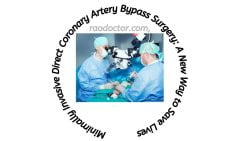
What is a minimally invasive direct coronary artery bypass?
Introduction
Minimally invasive direct coronary artery bypass surgery (MIDCAB) is a new way to save lives by addressing the challenges of conventional CAB. Minimally invasive direct coronary artery bypass surgery is an alternative to traditional on-table, off-pump coronary artery bypass grafting (CABG).
It’s also known as “video-assisted thoracoscopic surgery” (VATS) or “endoscopic” surgery, meaning that it’s performed through small tubes called endoscopes with tiny cameras mounted on them.
In the recent past, I had posted an article on treatment of Heart attack- click here to read it. As it goes, our world is ever changing; so is our health and for that, newer methods evolve to gain maximum benefits to the person undergoing the ordeal of health changes.
MIDCAB is one of those newer inventions or should I put as newer innovation in Cardiology? Whatever that may be, it sure has its advantages over open heart surgery for CABG.
In this article, we look at how MIDCAB works, its benefits compared to conventional CABG, and what we as surgeons can expect from this new technique.
What is a minimally invasive direct coronary artery bypass [MIDCAB]?
The goal of any bypass surgery is to reroute blood around blocked or diseased arteries using either arteries or veins so the heart can continue to pump blood normally. A coronary bypass graft, also known as CABG, reroutes blood around a blocked coronary artery by joining a healthy blood vessel to it.
MIDCAB is a new technique that uses a small, minimally invasive incision to access the patient’s heart and coronary arteries through the chest wall.

Instead of having a large scar from an open surgical procedure, patients have a small incision and can return to normal activities much sooner.
The heart is watched on a monitor during the procedure and a miniature video camera is inserted through the chest wall to view the heart as it’s being worked on.
How does minimally invasive direct coronary artery bypass work?
The surgeon makes a small incision near the patient’s clavicles [collarbones], usually between 0.5 and 1 centimeter in length. This access point is hidden by the breast tissue and is usually not visible.
Once the surgeon is inside the chest, the heart is visualized on a monitor and watched by the surgeon, who is standing at the patient’s head. The heart is watched on a monitor during the procedure and a miniature video camera is inserted through the chest wall to view the heart as it’s being worked on.
A special device called a robotic arm is used to position a surgical tool that delivers suction and hemostasis, meaning it stops bleeding, through the small incision.
A surgical support device is used to suspend the heart so that the surgeon and assistants have full access to the whole heart and coronary arteries.
Benefits of minimally invasive direct coronary artery bypass surgery
MIDCAB is a newer approach to CABG, but it has a lower rate of major complications such as heart attack, stroke, and kidney failure compared to on-table CABG.
In fact, according to this article in mercy.com, the rate of complications and death with MIDCAB is much less than that of conventional CABG. The death rate in MIDCAB is much lower than the death rate of conventional CABG, which is around 5%.
This means that death is less likely with MIDCAB and that more people will survive without significant long-term complications. Endoscopic surgery also reduces the length of stay in the hospital by one to two days compared to conventional CABG. This also means that patients can go home sooner and get back to their daily lives much faster.
Drawbacks of MIDCAB
Endoscopic surgery can be challenging in the hands of inexperienced surgeons because the smaller instruments and limited vision can make it difficult to see the anatomy clearly.
In addition, the reduced blood flow and working field can be challenging for the surgeon. The smaller space and limited visualization can make it more challenging for the surgeon to identify the anatomy and perform the procedure.
Finally, the smaller incision can make it more challenging for surgeons to re-open the chest wall and access the coronary arteries.
Key takeaways
MIDCAB surgery is a breakthrough in CABG because it enables surgeons to perform the surgery on the beating heart. This reduces the risk of blood loss and improves the flow of blood to the myocardium since the heart isn’t stopped like it is during conventional CABG.
With the advent of this technique, the mortality rate is extremely low, and most patients can leave the hospital days earlier than with conventional CABG. The main drawbacks are that it’s more challenging for the surgeon and that the smaller incision can make it more difficult to access the coronary arteries.

